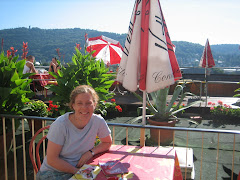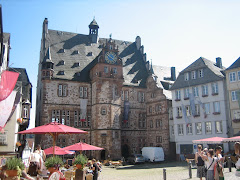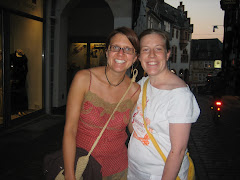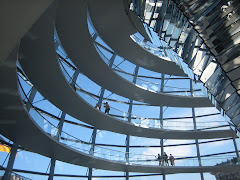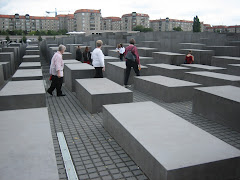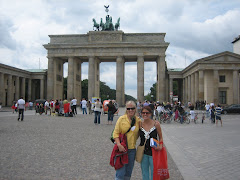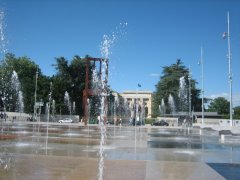Thanks to everyone for your support and well wishes this summer!
I returned home and am happy to announce that I have a new position working with the Minnesota State Colleges and Universities government relations team. It is so great to be back with my wonderful co-workers and serving in a job that is a passion of mine! I have also joined in on my classes at Humphrey Institute.
I look forward to catching up with all of my friends and family here. I also want to send a special thank you to my Swiss family! I had a great experience because of you!
Sunday, September 30, 2007
Friday, September 7, 2007
Military and peace
Soldier and peace, a bit like oil and water when you first think about it, but very fitting and very important to the peacebuilding process.
During this course, I have been very thankful to Major Ralf Lünsmann, who has taught me so much about the military's role in peacebuilding. A common task in our course is to break out into team syndicates and work on a problem together. While the groups are meeting, I have been able to learn from Ralf. He is a major in the Swiss military and teaches geography when he not serving. He has been deployed on three peacekeeping missions around the world.
Ralf taught me that there are two major military components to a United Nations peacekeeping mission. The military observers watch the areas to make sure that conflict will not break out and that local militias are abiding by the ceasefire agreement. These observers are unarmed and also travel into local villages to establish rapport with mayors and community leaders. They work together to monitor any potential uprisings and share information. The other military group is the general military presence. When the United Nations calls for a peace agreement, the number of troops to serve is established. UN ambassadors can volunteer their country for this role. Many times, the joint group is made up of armies from many different countries. All of these men fall under the rule of a force commander, who is appointed by the United Nations. This supervisor usually comes from the country that sends the most troops.
Overall, soldiers have a very important role in the peacebuilding process. The military can help build up roads that were destroyed during the conflict which can transport supplies. Likewise, the military doctors can assist at local hospitals. Soldiers can move supplies, bring relief aid to displaced people, and/or help rebuild homes. The roles for military in peacebuilding are truly endless!
Thanks to all of the soldiers out there who aid in these types of situations!
During this course, I have been very thankful to Major Ralf Lünsmann, who has taught me so much about the military's role in peacebuilding. A common task in our course is to break out into team syndicates and work on a problem together. While the groups are meeting, I have been able to learn from Ralf. He is a major in the Swiss military and teaches geography when he not serving. He has been deployed on three peacekeeping missions around the world.
Ralf taught me that there are two major military components to a United Nations peacekeeping mission. The military observers watch the areas to make sure that conflict will not break out and that local militias are abiding by the ceasefire agreement. These observers are unarmed and also travel into local villages to establish rapport with mayors and community leaders. They work together to monitor any potential uprisings and share information. The other military group is the general military presence. When the United Nations calls for a peace agreement, the number of troops to serve is established. UN ambassadors can volunteer their country for this role. Many times, the joint group is made up of armies from many different countries. All of these men fall under the rule of a force commander, who is appointed by the United Nations. This supervisor usually comes from the country that sends the most troops.
Overall, soldiers have a very important role in the peacebuilding process. The military can help build up roads that were destroyed during the conflict which can transport supplies. Likewise, the military doctors can assist at local hospitals. Soldiers can move supplies, bring relief aid to displaced people, and/or help rebuild homes. The roles for military in peacebuilding are truly endless!
Thanks to all of the soldiers out there who aid in these types of situations!
Tuesday, September 4, 2007
Peacebuilding 101
I am here in Spiez, Switzerland. The participants have arrived for the peacebuilding course!
Their first task was to break into four groups of 6. Each team was given a radio and a map. Our local military guru from the Swiss military, Ralf Lünsmann, manned the radios and communicated with each team on locations. The teams needed to find their way from the start to 3 different check points. At each stop, participants had to complete a group task. First, they walked on a plank together as a team and rode a pink Barbie bike with a skiddish wheel. At check point 2, where I was located, the teams had to start a fire with one match, boil water, put up a tent and get all teammates inside. The fastest team did this in 5 minutes. Can you imagine? Finally, the groups had to work together with planks and rocks to cross a "crocodile infested" river. It was great fun and a wonderful icebreaker.
Today, they have been learning conflict mediation. This is very similar to the training that I had as a resident assistant in Maple Hall. Yesterday, they began to lay out the fictious conflict "Mikeland," a project I have been editing and working on all summer long. It is great to see the end results!
On a different note, I have been able to reflect on this summer as I prepare a paper for class back home. It is very fruitful to see all that I have learned in the three months that I have been in Geneva. From learning about health care with my family of doctors, to learning about the United Nations during my courses and history during my travels, this definitely is an experience I will not forget!
Their first task was to break into four groups of 6. Each team was given a radio and a map. Our local military guru from the Swiss military, Ralf Lünsmann, manned the radios and communicated with each team on locations. The teams needed to find their way from the start to 3 different check points. At each stop, participants had to complete a group task. First, they walked on a plank together as a team and rode a pink Barbie bike with a skiddish wheel. At check point 2, where I was located, the teams had to start a fire with one match, boil water, put up a tent and get all teammates inside. The fastest team did this in 5 minutes. Can you imagine? Finally, the groups had to work together with planks and rocks to cross a "crocodile infested" river. It was great fun and a wonderful icebreaker.
Today, they have been learning conflict mediation. This is very similar to the training that I had as a resident assistant in Maple Hall. Yesterday, they began to lay out the fictious conflict "Mikeland," a project I have been editing and working on all summer long. It is great to see the end results!
On a different note, I have been able to reflect on this summer as I prepare a paper for class back home. It is very fruitful to see all that I have learned in the three months that I have been in Geneva. From learning about health care with my family of doctors, to learning about the United Nations during my courses and history during my travels, this definitely is an experience I will not forget!
Subscribe to:
Posts (Atom)
